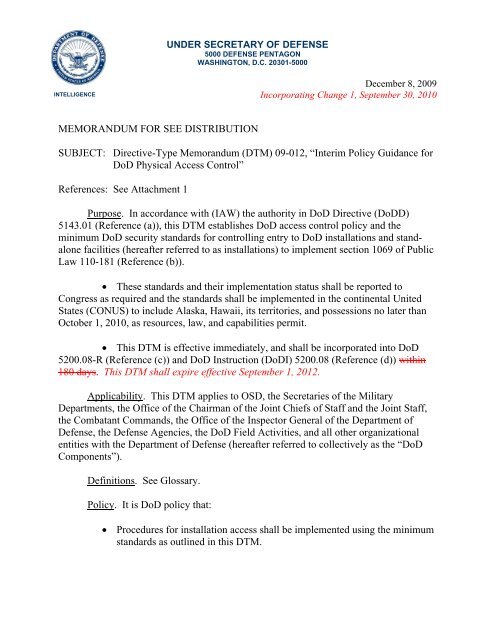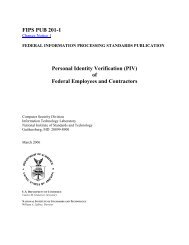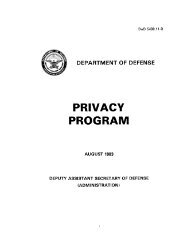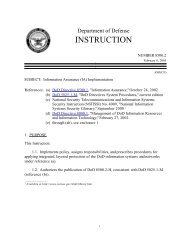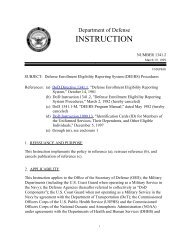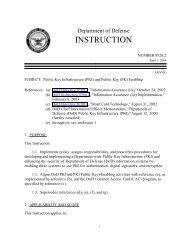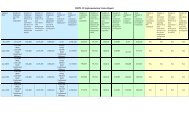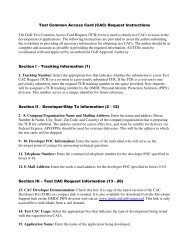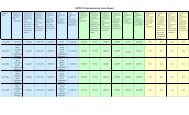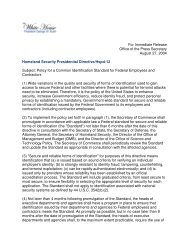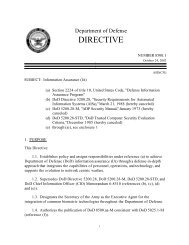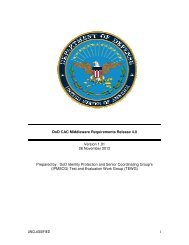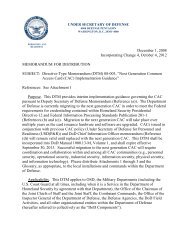DTM 09-012 - Common Access Card (CAC)
DTM 09-012 - Common Access Card (CAC)
DTM 09-012 - Common Access Card (CAC)
Create successful ePaper yourself
Turn your PDF publications into a flip-book with our unique Google optimized e-Paper software.
UNDER SECRETARY OF DEFENSE<br />
5000 DEFENSE PENTAGON<br />
WASHINGTON, D.C. 20301-5000<br />
INTELLIGENCE<br />
December 8, 20<strong>09</strong><br />
Incorporating Change 1, September 30, 2010<br />
MEMORANDUM FOR SEE DISTRIBUTION<br />
SUBJECT: Directive-Type Memorandum (<strong>DTM</strong>) <strong>09</strong>-<strong>012</strong>, “Interim Policy Guidance for<br />
DoD Physical <strong>Access</strong> Control”<br />
References: See Attachment 1<br />
Purpose. In accordance with (IAW) the authority in DoD Directive (DoDD)<br />
5143.01 (Reference (a)), this <strong>DTM</strong> establishes DoD access control policy and the<br />
minimum DoD security standards for controlling entry to DoD installations and standalone<br />
facilities (hereafter referred to as installations) to implement section 1069 of Public<br />
Law 110-181 (Reference (b)).<br />
• These standards and their implementation status shall be reported to<br />
Congress as required and the standards shall be implemented in the continental United<br />
States (CONUS) to include Alaska, Hawaii, its territories, and possessions no later than<br />
October 1, 2010, as resources, law, and capabilities permit.<br />
• This <strong>DTM</strong> is effective immediately, and shall be incorporated into DoD<br />
5200.08-R (Reference (c)) and DoD Instruction (DoDI) 5200.08 (Reference (d)) within<br />
180 days. This <strong>DTM</strong> shall expire effective September 1, 2<strong>012</strong>.<br />
Applicability. This <strong>DTM</strong> applies to OSD, the Secretaries of the Military<br />
Departments, the Office of the Chairman of the Joint Chiefs of Staff and the Joint Staff,<br />
the Combatant Commands, the Office of the Inspector General of the Department of<br />
Defense, the Defense Agencies, the DoD Field Activities, and all other organizational<br />
entities with the Department of Defense (hereafter referred to collectively as the “DoD<br />
Components”).<br />
Definitions. See Glossary.<br />
Policy. It is DoD policy that:<br />
• Procedures for installation access shall be implemented using the minimum<br />
standards as outlined in this <strong>DTM</strong>.
<strong>DTM</strong> <strong>09</strong>-<strong>012</strong>, December 8, 20<strong>09</strong><br />
• <strong>Access</strong> control standards shall include identity proofing, vetting to<br />
determine the fitness of an individual requesting and/or requiring access to<br />
installations, and issuance of local access credentials.<br />
o Documents listed in Attachment 4 of this <strong>DTM</strong> from the Department<br />
of Homeland Security Form I-9, “Employment Eligibility<br />
Verification” (see<br />
http://www.dhs.gov/xabout/gc_1186413412271.shtm), will be used<br />
for identity proofing.<br />
o Fitness of persons will be determined by U.S. Government (USG)<br />
personnel analysis and assessment of information obtained through<br />
USG authoritative data sources outlined in this <strong>DTM</strong> prior to being<br />
authorized unescorted access to installations.<br />
• Reciprocal physical access for DoD-issued card holders is authorized in this<br />
<strong>DTM</strong> to non-controlled and/or non-restricted DoD installations unless<br />
otherwise determined by the installation commander and/or director.<br />
Installation commanders may limit reciprocal physical access based upon,<br />
but not limited to, local security requirements, increased force protection<br />
condition (FPCON) levels, emergencies, and contingencies.<br />
• DoD-issued card holders as identified and authorized in this <strong>DTM</strong> should<br />
not be required to re-register at each installation (appropriate to their<br />
authorization for access) unless access is restricted and/or controlled based<br />
upon, but not limited to, higher security levels, increased FPCONs, or in<br />
compliance with local security requirements.<br />
• The DoD minimum standard for controlling access at an entry point to an<br />
installation shall be implemented as delineated in this <strong>DTM</strong>.<br />
• All unescorted persons entering DoD installations must have a valid<br />
purpose to enter, have their identity proofed and vetted, and be issued, or in<br />
possession of, an authorized and valid access credential.<br />
• Physical access control systems (PACSs) shall be reviewed for their<br />
capability to support current legacy components, future architectural<br />
requirements, and support interoperability across the Department of<br />
Defense.<br />
• Maximum use of approved commercial off-the-shelf technology solutions<br />
is encouraged.<br />
Change 1, <strong>09</strong>/30/2010<br />
2
<strong>DTM</strong> <strong>09</strong>-<strong>012</strong>, December 8, 20<strong>09</strong><br />
• PACSs shall include capabilities to provide for a greater level of security in<br />
depth, as defined in Reference (c), and be scalable.<br />
• Additional security measures shall be applied based on type of installation,<br />
security level, category of individuals, FPCONs, and level of access to be<br />
granted.<br />
• DoD Components should meet the physical access requirements established<br />
in this <strong>DTM</strong>, to the maximum extent possible, for special events,<br />
circumstances, and activities, and identify mitigation measures for those<br />
instances when the minimum standards cannot be met.<br />
• Personally identifiable information (PII) collected and utilized in the<br />
execution of this <strong>DTM</strong> must be safeguarded to prevent any unauthorized<br />
use, disclosure, and/or loss. DoD Components shall ensure that the<br />
collection, use, and release of PII complies with the requirements of DoDD<br />
5400.11, DoD 5400.11-R, and DoDI 5400.16 (References (e), (f), and (g)).<br />
Responsibilities. See Attachment 2.<br />
Procedures. See Attachments 3 and 4. Attachment 3 provides guidance for<br />
installation physical access control. Attachment 4 provides guidance for authorized DoD<br />
identification and identity proofing documents.<br />
Releasabilty. UNLIMITED. This <strong>DTM</strong> is approved for public release and is<br />
available on the Internet from the DoD Issuances Web Site at<br />
http://www.dtic.mil/whs/directives.<br />
Attachments:<br />
As stated<br />
Change 1, <strong>09</strong>/30/2010 3
<strong>DTM</strong> <strong>09</strong>-<strong>012</strong>, December 8, 20<strong>09</strong><br />
DISTRIBUTION:<br />
SECRETARIES OF THE MILITARY DEPARTMENTS<br />
CHAIRMAN OF THE JOINT CHIEFS OF STAFF<br />
UNDER SECRETARIES OF DEFENSE<br />
DEPUTY CHIEF MANAGEMENT OFFICER<br />
COMMANDERS OF THE COMBATANT COMMANDS<br />
ASSISTANT SECRETARIES OF DEFENSE<br />
GENERAL COUNSEL OF THE DEPARTMENT OF DEFENSE<br />
DIRECTOR, OPERATIONAL TEST AND EVALUATION<br />
DIRECTOR, COST ASSESSMENT AND PROGRAM EVALUATION<br />
INSPECTOR GENERAL OF THE DEPARTMENT OF DEFENSE<br />
ASSISTANTS TO THE SECRETARY OF DEFENSE<br />
DIRECTOR, ADMINISTRATION AND MANAGEMENT<br />
DIRECTOR, NET ASSESSMENT<br />
DIRECTORS OF THE DEFENSE AGENCIES<br />
DIRECTORS OF THE DoD FIELD ACTIVITIES<br />
Change 1, <strong>09</strong>/30/2010 4
<strong>DTM</strong> <strong>09</strong>-<strong>012</strong>, December 8, 20<strong>09</strong><br />
ATTACHMENT 1<br />
REFERENCES<br />
(a) DoD Directive 5143.01, “Under Secretary of Defense for Intelligence (USD(I)),”<br />
November 23, 2005<br />
(b) Section 1069 of Public Law 110-181, “National Defense Authorization Act for<br />
Fiscal Year 2008,” January 28, 2008<br />
(c) DoD 5200.08-R, “Physical Security Program,” April 9, 2007<br />
(d) DoD Instruction 5200.08, “Security of DoD Installations and Resources,”<br />
December 10, 2005<br />
(e) DoD Directive 5400.11, “DoD Privacy Program, May 8, 2007<br />
(f) DoD 5400.11-R, “Department of Defense Privacy Program,” May 14, 2007<br />
(g) DoD Instruction 5400.16, “DoD Privacy Act Assessment (PIA) Guidance,”<br />
February 12, 20<strong>09</strong><br />
(h) DoD Instruction 5200.01, “DoD Information Security Program and Protection of<br />
Sensitive Compartmented Information,” October 9, 2008<br />
(i)<br />
DoD Directive 5200.27, “Acquisition of Information Concerning Persons and<br />
Organizations not Affiliated with the Department of Defense,” January 7, 1980<br />
(j) DoD Directive 5015.2, “DoD Records Management Program,” March 6, 2000<br />
(k) DoD Directive 5230.20, “Visits and Assignments of Foreign Nationals,” June 22,<br />
2005<br />
(l)<br />
DoD Instruction 3224.03, “Physical Security Equipment (PSE) Research,<br />
Development, Test, and Evaluation (RTD&E),” October 1, 2007<br />
(m) DoD Instruction 1000.13, “Identification (ID) <strong>Card</strong>s for Members of the Uniformed<br />
Services, Their Dependents, and Other Eligible Individuals,” December 5, 1997<br />
(n) Federal Information Processing Standards Publication 201-1, “Personal Identity<br />
Verification for Federal Employees and Contractors,” March 2006<br />
(o) DoD Instruction 8510.01, “DoD Information Assurance Certification and<br />
Accreditation Process (DIACAP),” November 28, 2007<br />
5<br />
Change 1, <strong>09</strong>/30/2010 Attachment 1
<strong>DTM</strong> <strong>09</strong>-<strong>012</strong>, December 8, 20<strong>09</strong><br />
ATTACHMENT 2<br />
RESPONSIBILITIES<br />
1. UNDER SECRETARY OF DEFENSE FOR INTELLIGENCE (USD(I)). The<br />
USD(I) shall:<br />
a. Establish a working group under the DoD Physical Security Review Board that<br />
is chaired by the Physical Security Division Chief to address privacy, security, and<br />
physical access control issues for the protection of personnel, information, resources, and<br />
installations. The working group will:<br />
(1) Include, at a minimum, representation from the DoD Components,<br />
Physical Security Equipment Action Group (PSEAG), the Joint Security Chief Council,<br />
the Defense Privacy Office (DPO), and Service security expertise.<br />
(2) Establish physical security access control standards and other physical<br />
access control related guidance consistent with policy and approved published standards<br />
to support interoperability.<br />
(3) Recommend policy to manage physical access authorizations or denials<br />
for personnel entering their facilities.<br />
b. Establish policy regarding the collection, reporting, processing, storage,<br />
retention, redress, and destruction of information concerning individuals or organizations<br />
not affiliated with the Department of Defense or governed by DoDI 5200.01 (Reference<br />
(h)) and DoDD 5200.27 (Reference (i)). Policy will also address requirements and<br />
applicable laws under References (e) through (g) and DoDD 5015.2 (Reference (j)), as<br />
appropriate.<br />
c. Coordinate with the Under Secretary of Defense for Policy (USD(P)) and the<br />
Under Secretary of Defense for Acquisition, Technology, and Logistics (USD(AT&L)) to<br />
support the conduct of vulnerability and balanced survivability assessments of physical<br />
access control programs, processes, and systems, as required.<br />
d. Coordinate with the USD(AT&L) and the Under Secretary of Defense for<br />
Personnel and Readiness (USD(P&R)):<br />
(1) To provide oversight of the development of interfaces associated with<br />
controlling physical access.<br />
6<br />
Change 1, <strong>09</strong>/30/2010 Attachment 2
<strong>DTM</strong> <strong>09</strong>-<strong>012</strong>, December 8, 20<strong>09</strong><br />
(2) To develop technical and interface requirements for card issuance,<br />
revocation notification, and system interoperability with PACSs.<br />
(3) On identification card topology and physical security features (e.g.,<br />
holograms) to ensure compliance with resource, information security, and protection<br />
requirements.<br />
2. USD(P). The USD(P) shall:<br />
a. Coordinate with the USD(I) to establish and provide an interface to the Foreign<br />
Visitor System – Confirmation Module (FVS-CM) to provide information on and<br />
confirm foreign visitor authorizations to visit DoD locations including research,<br />
development, test, and evaluation (RDT&E) sites, all DoD Components, DoD contractor<br />
sites, and other sensitive DoD facilities, pursuant to DoDD 5230.20 (Reference (k)).<br />
b. Review physical security measures under FPCON levels to ensure compliance<br />
with this <strong>DTM</strong>.<br />
3. USD(AT&L). The USD(AT&L) shall:<br />
a. Coordinate RDT&E with the USD(I) in accordance with DoDI 3224.03<br />
(Reference (l)) for electronic physical access control and related systems.<br />
b. Provide biometrics technology support for physical security applications as<br />
required in accordance with References (c) and (l).<br />
c. In coordination with the USD(I) and USD(P&R), develop middleware interface<br />
capability to electronically verify enrollment of persons in authoritative databases.<br />
4. USD(P&R). The USD(P&R) shall:<br />
a. Coordinate with the USD(I) and USD(AT&L) to make available an interface to<br />
authenticate the identities of DoD personnel with authoritative databases.<br />
b. Coordinate with the USD(I) for changes to credentials that impact or require<br />
changes to physical security programs.<br />
5. ASSISTANT SECRETARY OF DEFENSE FOR NETWORKS AND<br />
INFORMATION INTEGRATION/DoD CHIEF INFORMATION OFFICER<br />
Change 1, <strong>09</strong>/30/2010<br />
7<br />
Attachment 2
<strong>DTM</strong> <strong>09</strong>-<strong>012</strong>, December 8, 20<strong>09</strong><br />
(ASD(NII)/DoD CIO). The ASD(NII)/DoD CIO shall coordinate with USD(I),<br />
USD(AT&L), and USD(P&R) to identify identity management requirements and IT<br />
solutions that provide DoD Components automated capabilities to verify and authenticate<br />
identities and identity credentials used in PACs.<br />
6. HEADS OF THE DoD COMPONENTS. The Heads of the DoD Components shall:<br />
a. Coordinate with the USD(I) on the security of DoD installations and resources<br />
in accordance with Reference (a), (c), and (d).<br />
b. Establish guidance and procedures to implement the guidelines and comply<br />
with requirements contained in this <strong>DTM</strong>, as resources permit.<br />
c. Ensure that privacy impact assessments are conducted in accordance with<br />
Reference (g).<br />
7. CHAIRMAN OF THE JOINT CHIEFS OF STAFF. The Chairman of the Joint<br />
Chiefs of Staff shall coordinate Combatant Commander requirements regarding these<br />
policy standards and provide recommendations to the USD(I) for policy and program<br />
consideration.<br />
Change 1, <strong>09</strong>/30/2010 8<br />
Attachment 2
<strong>DTM</strong> <strong>09</strong>-<strong>012</strong>, December 8, 20<strong>09</strong><br />
ATTACHMENT 3<br />
PHYSICAL SECURITY ACCESS CONTROL STANDARDS<br />
1. ACCESS CONTROL. <strong>Access</strong> control is designed to restrict and/or control entrance to<br />
property and/or installations to only those authorized persons and their conveyances.<br />
Persons authorized access shall be either escorted or unescorted. Commanders or<br />
directors will employ personnel access control measures at an installation perimeter to<br />
enhance security and protection of personnel, resources, and installations.<br />
2. PROOFING AND VETTING. The access control standards shall include identity<br />
proofing; determining the fitness of an individual requesting and/or requiring access to<br />
DoD facilities; and vetting.<br />
a. Federal personal identity verification (PIV) and DoD-issued card holders<br />
require identity proofing and vetting to determine fitness and eligibility for access.<br />
(1) Persons possessing a DoD-issued <strong>Common</strong> <strong>Access</strong> <strong>Card</strong> (<strong>CAC</strong>) are<br />
vetted to DoD Personnel Security standards in subparagraphs 2.a.(1)(a) and (b) of this<br />
attachment and shall be considered identity proofed.<br />
(a) DoD Civilian Personnel and/or Contractors. National Agency<br />
Check with Inquiries (NACI) or Office of Personnel Management (OPM) Tier I<br />
standards, when implemented.<br />
(b) DoD Military Personnel. National Agency Check with Law and<br />
Credit or OPM Tier II standards, when implemented.<br />
(2) Persons possessing a DoD-issued card IAW DoDI 1000.13<br />
(Reference (m)) are identity proofed at card issuance sites from federally authorized<br />
identity documents and shall be considered identity proofed.<br />
(3) Persons possessing Federal PIV credentials that conform to<br />
Reference (h) are vetted and adjudicated by Government security specialists on NACI or<br />
OPM Tier I standards, when implemented, and shall be considered identity proofed.<br />
(4) The Transportation Worker Identification Credential (TWIC) holders<br />
vetting, adjudication, and issuance process is comparable to the NACI and/or National<br />
Agency Check with Law and Credit or, when implemented, OPM Tier I standard, and<br />
shall be considered identity proofed.<br />
9<br />
Change 1, <strong>09</strong>/30/2010 Attachment 3
<strong>DTM</strong> <strong>09</strong>-<strong>012</strong>, December 8, 20<strong>09</strong><br />
(5) Vetting and adjudication for persons receiving USG identification<br />
credentials as listed in subparagraphs 2.a.(1), (3), and (4) of this attachment occurs prior<br />
to permanent card issuance. Persons in possession of these identification cards and/or<br />
credentials shall be considered vetted for unescorted access for the purposes of this <strong>DTM</strong>.<br />
(6) Determination of fitness and vetting for DoD-issued identification and<br />
privilege cards (subparagraph 2.a.(2) of this attachment) should not be required for<br />
unescorted access, as the issuing office verifies the individual’s direct affiliation with the<br />
Department of Defense, or a specific DoD sponsor, and eligibility for DoD benefits and<br />
entitlements.<br />
b. Non-Federal Government and non-DoD-issued card holders who are provided<br />
unescorted access require identity proofing and vetting to determine fitness and eligibility<br />
for access.<br />
(1) Persons requesting access shall provide justification and/or purpose for<br />
access to DoD facilities.<br />
(2) Persons requesting access that are not in possession of an approved,<br />
Government issued card shall provide a document listed in Attachment 4. The<br />
documents presented shall be reviewed by an authorized Government representative for<br />
the purposes of identity proofing.<br />
(3) The local commander and/or director shall determine the recurring<br />
requirement and frequency for additional checks of non-Federal Government and<br />
non-DoD-issued card holders based upon local security requirements using Government<br />
authoritative databases only as prescribed herein.<br />
(4) Installation government representatives shall query the following<br />
government authoritative data sources to vet the claimed identity and to determine<br />
fitness, using biographical information including, but not limited to, the person’s name<br />
date of birth, and social security number:<br />
(a) The National Crime Information Center (NCIC) database.<br />
(b) The Terrorist Screening Database.<br />
(c) Other sources as determined by the DoD Component or the local<br />
commander and/or director. These can include but are not limited to:<br />
1. Department of Homeland Security (E-Verify).<br />
2. Department of Homeland Security (U.S. VISIT).<br />
Change 1, <strong>09</strong>/30/2010 10<br />
Attachment 3
<strong>DTM</strong> <strong>09</strong>-<strong>012</strong>, December 8, 20<strong>09</strong><br />
3. Department of State Consular Checks (non-U.S. citizen).<br />
4. The FVS-CM.<br />
(5) Only personnel delegated by the installation commander shall perform<br />
access control duties that include:<br />
(a) Identity proofing.<br />
(b) Vetting and determination of fitness.<br />
(c) <strong>Access</strong> authorizations and privileges.<br />
authorized.<br />
(6) Installation personnel will issue the appropriate card and/or pass, as<br />
c. Commander(s) and/or directors(s) of installations are authorized to conduct<br />
random proofing and vetting on persons requiring access to their assigned installations, as<br />
necessary and appropriate.<br />
3. MINIMUM STANDARDS FOR CONTROLLING PHYSICAL ACCESS TO<br />
INSTALLATIONS<br />
a. The DoD minimum standard for controlling physical access to an installation<br />
shall be:<br />
(1) Where electronic PACSs are not appropriate due to limited access<br />
control or mission requirements, a physical and visual inspection of cards as authorized in<br />
this <strong>DTM</strong> shall be conducted by security forces and/or guards at physical entry and/or<br />
access control points. This inspection includes:<br />
(a) Visual match of the photograph on the card to the person<br />
presenting the identification.<br />
(b) Comparison and visual review of the card for unique topology<br />
and security design requirements. The visual check of the card will include verifying<br />
authenticity by checking the anti-counterfeit and/or fraud protection measures embedded<br />
in the credential.<br />
Change 1, <strong>09</strong>/30/2010 11<br />
Attachment 3
<strong>DTM</strong> <strong>09</strong>-<strong>012</strong>, December 8, 20<strong>09</strong><br />
(2) When funding becomes available, installations will procure an<br />
electronic PACS that provides the capability to rapidly and electronically authenticate<br />
credentials and individuals authorization to enter an installation. The PACS must support<br />
a DoD-wide and federally interoperable access control capability that can authenticate<br />
USG physical access credentials and support access enrollment, authorization processes,<br />
and securely share information.<br />
b. Types of access include:<br />
(1) Unescorted individuals.<br />
(2) Escorted individuals.<br />
c. Other considerations for controlling access include, but are not limited to:<br />
(1) Escort qualifications, responsibilities, and authorizations.<br />
(2) Sponsorship qualifications, responsibilities, and authorizations.<br />
(3) <strong>Access</strong> privileges at each security level and each FPCON.<br />
(4) Mission-essential employee designation, if applicable.<br />
(5) Emergency response designation, if applicable.<br />
(6) Day and time designation for access.<br />
(7) Locations authorized for access.<br />
d. DoD Components should provide reciprocal physical access to installations for<br />
DoD-issued card holders authorized by this <strong>DTM</strong>. Commanders may limit reciprocal<br />
physical access based upon, but not limited to, local security requirements, increased<br />
FPCON levels, and emergencies.<br />
e. DoD Components may incorporate a DoD defined Trusted Traveler procedure<br />
for use during FPCONs NORMAL, ALPHA, and BRAVO into their implementation<br />
policy as local security conditions permit. The Trusted Traveler procedure is governed<br />
and implemented locally and is not recognized from installation to installation.<br />
(1) The Trusted Traveler procedure allows a uniformed service member or<br />
Government employee with a valid <strong>CAC</strong>, a military retiree (with a valid DoD<br />
identification credential), or an adult dependent (with a valid DoD identification<br />
credential) to present their identification token for verification while simultaneously<br />
Change 1, <strong>09</strong>/30/2010 12<br />
Attachment 3
<strong>DTM</strong> <strong>09</strong>-<strong>012</strong>, December 8, 20<strong>09</strong><br />
vouching for any vehicle occupants. The number of personnel a Trusted Traveler is<br />
allowed to vouch for and/or sponsor at any one time will be determined by the local<br />
installation commander or their designated representative.<br />
(2) Members identified as Trusted Travelers are responsible for the actions<br />
of all occupants for whom they vouch and for meeting all security requirements for escort<br />
as established by the Service or installation commander.<br />
4. PACS AND COMPONENTS<br />
a. In order to meet the DoD goal of enhancing security for DoD installations,<br />
personnel, information, and resources, PACSs and their components shall:<br />
(1) Query government authoritative data sources for the vetting of persons<br />
requiring access.<br />
(2) Support DoD-wide and Federal Government-wide interoperability for<br />
Federal PIV IAW Reference (g).<br />
(3) Validate and authenticate government issued identification.<br />
(4) Integrate with other physical security systems and equipment.<br />
b. In addition to the security systems goals outlined in subparagraphs 4.a.(1)<br />
through (4) of this attachment, PACSs and associated components:<br />
components.<br />
(1) Shall be reviewed for their capability to support legacy PACSs and<br />
(2) Shall provide for scalable capabilities.<br />
(3) Shall provide a secure capability to query and receive information to<br />
vet individuals seeking access to installations by checking an individual’s biographic<br />
information against government authoritative data sources and watch lists to determine an<br />
individual’s fitness and eligibility for access. Biometrics may be added to the biographic<br />
information check when infrastructure, capability, and resources are available and<br />
mission requirements dictate their use.<br />
(4) Shall provide a capability to exchange controlled information across<br />
the physical security enterprise with other USG security, law enforcement, and<br />
intelligence sources.<br />
Change 1, <strong>09</strong>/30/2010 13<br />
Attachment 3
<strong>DTM</strong> <strong>09</strong>-<strong>012</strong>, December 8, 20<strong>09</strong><br />
(5) Shall provide the capability to report and to receive information for<br />
revoked, lost, or stolen identification cards, debarments, restricted persons, and other<br />
information pertaining to the security and protection of DoD installations, persons, and<br />
resources.<br />
(6) Shall provide capability to check Federal PIV and DoD-issued cards to<br />
verify their authenticity and for electronic authentication against physical access control<br />
lists in the PACS database.<br />
(7) Shall provide capability to maintain local logging and reporting of<br />
persons enrolled in PACS, entering the installation, and denied access.<br />
(8) Shall provide capability to store an updated access control list every 12<br />
hours (or dependent on local requirements), which can be accessed offline by authorized<br />
security personnel during losses of communication to PACS databases.<br />
(9) Shall read contact and contactless technology IAW the Federal<br />
Information Processing Standards Publication 201-1 (Reference (n)). Contactless<br />
technology will be the primary technology used, as it provides for more rapid throughput<br />
and supports less wear and tear on the reader and the card.<br />
(10) Shall provide capability to take, store, and forward to guard stations a<br />
facial image and/or digital photograph obtained during registration to perform visual<br />
match of the person presenting the credential, card, or pass.<br />
(11) Shall comply with the requirements of DoDI 8510.01 (Reference (o))<br />
regarding certification and accreditation.<br />
(12) Shall include an emergency power source.<br />
(13) May provide capability to interface with Service vehicle registration<br />
systems, as appropriate.<br />
(14) May provide capability to match the biometric presented (i.e., facial<br />
image, and fingerprint) to the individual and to the vetted claimed identity in the PACS.<br />
(15) May provide keypad for personal identification number (PIN) usage<br />
or for additional levels of security.<br />
(16) May provide capability to incorporate radio frequency identification<br />
tags technology.<br />
Change 1, <strong>09</strong>/30/2010 14<br />
Attachment 3
<strong>DTM</strong> <strong>09</strong>-<strong>012</strong>, December 8, 20<strong>09</strong><br />
(17) Should provide a capability to support two-factor authentication<br />
(visual, mechanical, and/or electronic) to provide higher levels of assurance, as dictated<br />
by risk, cost, or when otherwise required.<br />
5. ADDITIONAL SECURITY REQUIREMENTS. DoD Components may authorize<br />
additional security requirements based upon the type of installation, security level,<br />
category of individuals requiring access, FPCONs, and level of access to be granted, as<br />
necessary. Installation commanders and/or directors will determine local requirements<br />
for personnel under the age of 18 who require non-recurring access and are not in<br />
possession of an authorized identification or identity source documents listed in this<br />
<strong>DTM</strong>.<br />
6. SPECIAL EVENTS, CIRCUMSTANCES, OR ACTIVITIES. Requirements for<br />
physical access for special events, circumstances, or activities shall be determined in the<br />
implementation policy of the DoD Components and will include compensatory measures<br />
when the requirements of the <strong>DTM</strong> cannot be met.<br />
7. LOCAL EMERGENCY RESPONSE/ASSISTANCE. Procedures for local<br />
emergency first responders’ physical access requirements shall be developed and<br />
implemented by installation commanders.<br />
Change 1, <strong>09</strong>/30/2010<br />
15<br />
Attachment 3
<strong>DTM</strong> <strong>09</strong>-<strong>012</strong>, December 8, 20<strong>09</strong><br />
ATTACHMENT 4<br />
IDENTITY PROOFING DOCUMENTS AND AUTHORIZED IDENTIFICATION<br />
1. ACCEPTABLE IDENTIFICATION DOCUMENTS. Applicants will provide a valid<br />
and original form of identification from those listed in section 2 of this attachment for the<br />
purpose of proofing identity for enrollment into a PACS or issuance of a visitor pass.<br />
Prior to acceptance, personnel processing an applicant will screen documents for<br />
evidence of tampering, counterfeiting, or other alteration. Documents that appear<br />
questionable (e.g., having damaged laminates) or otherwise altered will not be accepted.<br />
Altered documents will be held until appropriate authorities are notified, and disposition<br />
procedures are authorized.<br />
2. ACCEPTABLE IDENTITY SOURCE DOCUMENTS. All documents must be<br />
current.<br />
a. U.S. passport or U.S. passport card.<br />
b. Permanent resident card or Alien Registration Receipt <strong>Card</strong> (INS Form I-551).<br />
c. Foreign passport with a temporary (I-551) stamp or temporary (I-551) printed<br />
notation on a machine readable immigrant visa.<br />
d. Foreign passport with a current arrival-departure record (INS Form I-94)<br />
bearing the same names as the passport and containing an endorsement of the alien’s<br />
nonimmigrant status, if that status authorizes the alien to work for the employer.<br />
e. Employment authorization document that contains a photograph (INS Form<br />
I-766).<br />
f. In the case of a nonimmigrant alien authorized to work for a specific employer<br />
incident to status, a foreign passport with INS Form I-94 or INS Form I-94A bearing the<br />
same name as the passport and containing an endorsement of the alien’s nonimmigrant<br />
status, as long as the endorsement has not yet expired and the proposed employment is<br />
not in conflict with any restrictions or limitations identified on the form.<br />
g. Driver’s license or identification card issued by a State or outlying possession<br />
of the United States, provided it contains a photograph and biographic information such<br />
as name, date of birth, gender, height, eye color, and address.<br />
Change 1, <strong>09</strong>/30/2010 16<br />
Attachment 4
<strong>DTM</strong> <strong>09</strong>-<strong>012</strong>, December 8, 20<strong>09</strong><br />
h. Identification card issued by Federal, State, or local government agencies,<br />
provided it contains a photograph and biographic information such as name, date of birth,<br />
gender, height, eye color, and address.<br />
i. School identification card with a photograph.<br />
j. U.S. Military or draft record.<br />
k. U.S. Coast Guard Merchant Mariner <strong>Card</strong> or TWIC.<br />
l. Native American tribal document.<br />
m. For persons under the age of 18 who are unable to present a document listed in<br />
paragraphs 2.a. through m. of this attachment:<br />
(1) School record or report card.<br />
(2) Day care or nursery school record.<br />
(3) Birth certificate.<br />
3. AUTHORIZED IDENTIFICATION TO FACILITATE PHYSICAL ACCESS<br />
a. Identification documents authorized to facilitate physical access to installations<br />
include:<br />
(1) The DoD <strong>CAC</strong>.<br />
(2) DoD Uniformed Services Identification and Privileges <strong>Card</strong>s issued in<br />
accordance with Reference (m).<br />
(3) USG-issued, authenticated Federal PIV credentials.<br />
(4) TWIC.<br />
b. For other persons requiring unescorted access, installation commanders shall<br />
use locally produced, temporary issue, visitor identification. Commanders must ensure<br />
that an expiration date and time group is assigned to these temporary credentials.<br />
Change 1, <strong>09</strong>/30/2010<br />
17<br />
Attachment 4
<strong>DTM</strong> <strong>09</strong>-<strong>012</strong>, December 8, 20<strong>09</strong><br />
GLOSSARY<br />
PART I. ABBREVIATIONS AND ACRONYMS<br />
ASD(NII)/<br />
DoD CIO<br />
<strong>CAC</strong><br />
CONUS<br />
DoDD<br />
DoDI<br />
DPO<br />
<strong>DTM</strong><br />
FPCON<br />
FVS-CM<br />
IAW<br />
NACI<br />
NCIC<br />
OPM<br />
PACS<br />
PII<br />
PIN<br />
PIV<br />
PSEAG<br />
RDT&E<br />
TWIC<br />
USD(AT&L)<br />
USD(I)<br />
USD(P)<br />
USD(P&R)<br />
USG<br />
Assistant Secretary of Defense for Networks and Information<br />
Integration/DoD Chief Information Officer<br />
<strong>Common</strong> <strong>Access</strong> <strong>Card</strong><br />
continental United States<br />
Department of Defense Directive<br />
Department of Defense Instruction<br />
Defense Privacy Office<br />
Directive-Type Memorandum<br />
force protection condition<br />
Foreign Visitor System – Confirmation Module<br />
in accordance with<br />
National Agency Check with Inquiries<br />
National Crime Information Center<br />
Office of Personnel Management<br />
Physical <strong>Access</strong> Control System<br />
personally identifiable information<br />
personal identification number<br />
personal identity verification<br />
Physical Security Equipment Action Group<br />
research, development, test, and evaluation<br />
Transportation Workers Identification Credential<br />
Under Secretary of Defense for Acquisition, Technology, and<br />
Logistics<br />
Under Secretary of Defense for Intelligence<br />
Under Secretary of Defense for Policy<br />
Under Secretary of Defense for Personnel and Readiness<br />
United States Government<br />
Change 1, <strong>09</strong>/30/2010<br />
18<br />
Glossary
<strong>DTM</strong> <strong>09</strong>-<strong>012</strong>, December 8, 20<strong>09</strong><br />
PART II. DEFINITIONS<br />
These terms and their definitions are for the purpose of this <strong>DTM</strong>.<br />
access control. See “physical access control.”<br />
access control list. A list containing (at a minimum) the names of individuals authorized<br />
access and their subsequent authorities of sponsorship (e.g., privileges, times and/or dates<br />
for access, unescorted or escorted designation). In an electronic PACS, these items are<br />
logically stored in the PACS database.<br />
access credential. A physical artifact issued by the Federal, State, or local government<br />
that attests to one’s right to credit or authority. The access credential contains and/or<br />
depicts characteristics, authorizations, and privileges for physical access and internal<br />
security controls.<br />
applicant. An individual requesting physical access to a facility and/or installation.<br />
application. A hardware and/or software system implemented to satisfy a particular set of<br />
requirements.<br />
architecture. A highly structured specification of an acceptable approach within a<br />
framework for solving a specific problem. An architecture contains descriptions of all<br />
the components of a selected, acceptable solution while allowing certain details of<br />
specific components to be variable to satisfy related constraints (e.g., costs, local<br />
environment, user acceptability, and Federal, State, or local laws).<br />
authentication. A process that matches presented information to the established origin of<br />
that information.<br />
biographic information. Facts of, or relating to, a person that asserts and/or supports the<br />
establishment of their identity. The identity of U.S. citizens is asserted by their social<br />
security number and given name. Other biographic information may include, but is not<br />
limited to, identifying marks such as tattoos, birthmarks, etc.<br />
biometrics. A general term used to alternatively describe a characteristic or process.<br />
Stored electronic information pertaining to a biometric can be in terms of raw or<br />
compressed pixels, or in terms of some characteristic (e.g., patterns).<br />
controlled area. A controlled space extending upward and outward from a specified<br />
point. Installations are generally considered controlled areas for the purposes of national<br />
defense. Commanders and/or directors may further designate controlled areas within an<br />
Change 1, <strong>09</strong>/30/2010<br />
19<br />
Glossary
<strong>DTM</strong> <strong>09</strong>-<strong>012</strong>, December 8, 20<strong>09</strong><br />
installation based upon geographic attributes and unit dispersal. Controlled areas<br />
generally designate areas wherein sensitive operations occur or controlled unclassified<br />
and sensitive information is stored and access is limited to specific persons.<br />
DoD issued card. <strong>Card</strong>s (other than the DoD <strong>CAC</strong>) authorized by Reference (m) of this<br />
<strong>DTM</strong>.<br />
escorted individuals. Persons who require access, without determination of fitness, who<br />
must be accompanied by a sponsor with authorization to escort the individual. The escort<br />
requirement is mandated for the duration of the individual’s visitation period.<br />
Federal PIV. A physical artifact issued by the Federal Government to an individual that<br />
contains a photograph, cryptographic keys, and a digitized fingerprint representation so<br />
that the claimed identity of the card holder can be verified by another person (human<br />
readable and verifiable) or a computer system readable and verifiable. This card is<br />
conformant with the standards prescribed in Reference (n).<br />
fitness. Level of character and conduct determined necessary for the basis of access<br />
control decisions.<br />
identity proofing. The process of providing or reviewing federally authorized acceptable<br />
documentation (INS Form I-9) for authenticity.<br />
physical access control. The process of physically controlling personnel and vehicular<br />
entry to installations, facilities, and resources. <strong>Access</strong> will be either unescorted or<br />
escorted.<br />
physical electronic security system interoperability. The ability of two or more systems<br />
or components to exchange information or electronic data and to use the information that<br />
has been exchanged.<br />
physical security. That part of security concerned with active and passive measures<br />
designed to prevent unauthorized access to personnel, equipment, installations, and<br />
information, and to safeguard them against espionage, sabotage, terrorism, damage, and<br />
criminal activity. Designed for prevention and provides the means to counter threats<br />
when preventive measures are ignored or bypassed.<br />
Physical Security <strong>Access</strong> Control Identity and Information Management System. A<br />
system comprised of one or more systems or applications that controls the ability of<br />
people or vehicles to enter a protected area by means of visual, manual, or electronic (or a<br />
combination of the three) authentication and authorization at entry points, and manages<br />
identity information for controlling physical access to eligible, authorized persons.<br />
Change 1, <strong>09</strong>/30/2010<br />
20<br />
Glossary
<strong>DTM</strong> <strong>09</strong>-<strong>012</strong>, December 8, 20<strong>09</strong><br />
PII. Information that can be used to distinguish or trace an individual’s identity, such as<br />
their name, social security number, date and place of birth, mother’s maiden name, and<br />
biometric records, including any other personal information which is linked or linkable to<br />
a specific individual.<br />
reciprocal physical access. Mutual recognition of physical access privileges granted by<br />
an installation commander.<br />
restricted access area. An area (land, sea, or air) in which there are special restrictive<br />
measures employed to prevent or minimize incursions and/or interference, where special<br />
security measures are employed to prevent unauthorized entry and/or movement.<br />
Restricted areas are designated and authorized by the installation and/or activity<br />
commander and/or director, properly posted, and employ multiple physical security<br />
measures.<br />
screening. The physical process of reviewing a person’s presented biographic and other<br />
identifiable information, as appropriate, to determine their authenticity, authorization, and<br />
credential verification against a government data source through authorized and secure<br />
channels at anytime during the person’s period of physical access eligibility. This<br />
assessment identifies derogatory actions that can be determined as disqualifying issues<br />
for current or continuing physical access eligibility standards and requirements for the<br />
resource, asset, or installation.<br />
security in depth. A combination of layered and complementary security controls<br />
sufficient to deter, detect, and document unauthorized entry and movement within the<br />
installation and/or facility and the ability to delay and respond with force. Examples<br />
include the use of perimeter fences, employee and visitor entry and/or exit controls,<br />
sensors and intrusion detection systems, closed circuit video monitoring, security patrols<br />
during working and non-working hours, or other safeguards that mitigate vulnerabilities.<br />
Trusted Traveler. A procedure that allows for uniformed service members and spouses,<br />
DoD employees, and retired uniformed service members and spouses to vouch for<br />
occupants in their immediate vehicle, provided the Trusted Traveler vehicle operator<br />
possess a valid identification card and has a clear NCIC check. Trusted Travelers are<br />
entirely responsible for the actions of all occupants in their vehicle and for meeting all<br />
local security requirements for escort as established by requirements of the installation<br />
commander. Additional implementation guidance will be incorporated into physical<br />
security policy.<br />
unescorted individuals. Personnel who have been identity proofed and favorably vetted<br />
in accordance with this <strong>DTM</strong> are eligible for unescorted access within the installation;<br />
but are, however, still subject to any controlled or restricted area limitations, as<br />
appropriate.<br />
Change 1, <strong>09</strong>/30/2010<br />
21<br />
Glossary
<strong>DTM</strong> <strong>09</strong>-<strong>012</strong>, December 8, 20<strong>09</strong><br />
vetting. An evaluation of an applicant’s or a card holder’s character and conduct for<br />
approval, acceptance or denial for the issuance of an access control credential or physical<br />
access.<br />
Change 1, <strong>09</strong>/30/2010<br />
22<br />
Glossary


